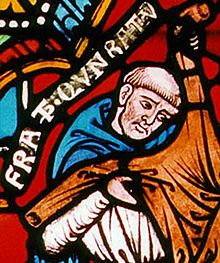- Konrad von Marburg
-
 Konrad von Marburg, detail of a 13th century church window, Elisabeth Church, Marburg.
Konrad von Marburg, detail of a 13th century church window, Elisabeth Church, Marburg.
Konrad von Marburg (sometimes Anglicised as Conrad of Marburg; died 30 July 1233) was a medieval German inquisitor. He was commissioned by the Pope to combat the Albigensians, whom the Roman Catholic Church considered heretics. He is known for the extreme methods he employed, and for the early death that these methods brought him.
Biography
Konrad's early life is not well known, but he was described by contemporary church sources as well educated and highly knowledgeable. It is possible that he received a university education. He was also noted for his strong asceticism and his zeal in defending the church. Konrad long was considered to have been a member of the Dominican Order, but modern scholarly consensus holds that he was not. Much of his early work within the church was related to the suppression of heresy, and he took an active part in the Albigensian Crusade in southern France. Pope Innocent III, who championed the Crusade and the accompanying Medieval Inquisition, was one of Konrad's early supporters.
Eventually, however, Konrad returned to Germany, the land of his birth. He gradually acquired a position of considerable influence at the court of Louis IV, Landgrave of Thuringia. In particular, Konrad gained considerable power over Louis' wife, Elisabeth of Hungary, to whom Konrad acted as religious advisor and confessor. In this role, Konrad's treatment of Elisabeth was extremely harsh, and he held her to standards of behaviour which were almost impossible to meet. Among the punishments he is alleged to have ordered were physical beatings and separation from her three children. In 1231, possibly because of Konrad's treatment of her, Elisabeth died. She was soon elevated to sainthood as St. Elisabeth, and became one of the two or three most eminent female saints of medieval times (and beyond). In modern scholarly literature, generally a strongly sadistic element has been diagnosed in Konrad's behavior towards Elisabeth.
Konrad also set to work seeking out heresy in both Thuringia and Hesse, and quickly gained a reputation for being unreasonable and unjust. According to most accounts, Konrad accepted almost any accusation as true, and regarded suspects as guilty until proven innocent. Those accused of being heretics were quickly sought out by Konrad's mobs, and told to repent or else be burnt at the stake. Those accused of heresy were also encouraged to falsely denounce others, with the implication that their own lives might be spared if they did so. Konrad included commoners, nobles, and priests in his inquisition: Heinrich Minnike, Provost of Goslar, was one of Konrad's first targets, and was burnt at the stake. In 1227, Pope Gregory IX commissioned Konrad to eliminate heresy throughout the whole of Germany, granting him permission to ignore standard church procedure for the investigation of heresy. According to many sources, news that Konrad was to pass through an area almost invariably caused widespread panic.
In 1233, Konrad accused Henry II, Count of Sayn, of taking part in "satanic orgies". Henry, however, appealed to an assembly of bishops in Mainz and was declared innocent. Konrad refused to accept the decision and demanded that the verdict be reversed, but eventually left Mainz to return to Marburg. On the road, he was attacked by several knights, who killed both Konrad and his assistant. The knights may or may not have been in the service of Henry.
After Konrad's death, Pope Gregory declared Konrad to have been an upholder of the Christian faith, and ordered his killers punished. Perceptions in Germany, however, were markedly less favourable, and the memory of Konrad was enough to turn opinion against the Inquisition for many years.
Not only locally, and not diminishing over the centuries, the name of Konrad von Marburg became a byword for sadism and the dark side of Catholicism. The place where Konrad was killed, Hof Kapelle near Marburg, is marked with a stone (within the premises of a private farm); it was locally long believed to be haunted and is allegedly today on certain days the site of black rites. A fountain on the lower Steinweg, one of Marburg's main lanes, close to St. Elisabeth Church, which in some neo-gothic restoration attempt was topped with the effigy of a generic monk that was locally believed to represent Konrad, was continuously stoned by the students of the University of Marburg, and after many attempts at replacement, had to be substituted with an architectural ornament.
Konrad appears in a work by the English novelist Charles Kingsley, who wrote his Saint's Tragedy about Elisabeth.
Popular culture
Konrad von Marburg is pictured as the main character in the French comic strip "The Third Testament" by Xavier Dorison and Alex Alice. After hiding for 20 years after being sentenced to death by an Inquisition Tribunal framed by Henry of Sayn, a mellowed and weary Konrad (somewhat resembling actor Sean Connery) again faces the mysterious Count of Sayn in a race to find a legendary document, the “Third Testament”. The story is a 4-part suite published by Glénat.
See also
Categories:- 1233 deaths
- Inquisitors
- People of the Albigensian Crusade
Wikimedia Foundation. 2010.
